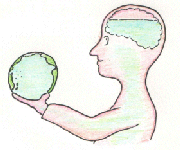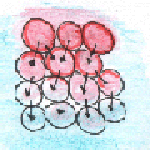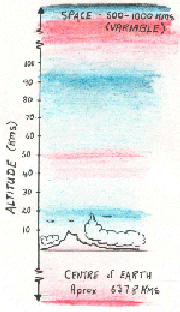|
Water is part of every living organism,
including humans. We are 55-65% water and organs like our brains are
70-80% water.
Water can exist in all three states (liquid, solid,
vapour) at once and does so on Earth.
It is a liquid between 0°C
and 100°C
and so can exist as a liquid on most parts of the planet. Oceans cover
71% of Earth’s surface.
It conducts thermal energy more easily than
any liquid except mercury. This means it acts to moderate temperature differences in the
oceans and also within each of us.
It is slow to heat and slow to cool.
This moderates surface temperatures of the planet and it helps
each of us resist changes to our own temperatures from sudden weather
changes. This property means that relatively
small changes to the amount of water vapour in the atmosphere can produce
large variations in weather.
It is ‘sticky’ and forms drops. This enables it to form tiny water
droplets or ice crystals around tiny dust particles (cloud condensation
nuclei) in the air. It also enables water to move through our
capillaries.
The white cloud, ice and snow forms of water
scatter sun light around the atmosphere and reflect it back out into space.
Also when sunlight strikes water at an angle it tends to be reflected. This helps maintain the thermal balance of Earth.
It is unique in that its solid form floats on its
liquid form i.e. is less dense when solid. This property works to
support life on Earth.
Water vapour absorbs low frequency waves of energy e.g. the
infrared waves emitted from the sun and from Earths surface. It re-emits them in all
directions, including back to Earth’s surface. Without water vapour in
the atmosphere Earth’s surface would be about 31°C
cooler! Combined, the other Warmer Trace Gases make about 2°C
difference to the global surface temperature. e.g. the
infrared waves emitted from the sun and from Earths surface. It re-emits them in all
directions, including back to Earth’s surface. Without water vapour in
the atmosphere Earth’s surface would be about 31°C
cooler! Combined, the other Warmer Trace Gases make about 2°C
difference to the global surface temperature.
It is concentrated in the bottom layer of the atmosphere and then only
in certain regions of the globe. 99% of water vapour and ‘weather’
is found in the troposphere i.e. within 8-15kms of Earth’s surface. It
is barely detectable in -40°C
Antarctic air (0.0001% of the air). It can be 4% of the +40°C
Saharan Desert air.
About 0.001% (13000 cu. kms) of the mass of Earth’s
water is in the atmosphere. There is 45000 times as much in the oceans
(1400 million cu. kms). Each day about 250 cu. kms evaporates into the
atmosphere and this is balanced by precipitation (rain, mist, drizzle,
hail, snow falls).
The movement of both the oceans and the atmosphere
transfer thermal energy from warmer regions to cooler regions. In the
absence of water the poles would be much cooler and the tropics much
warmer. Similarly the extremes between day and night surface
temperatures would be much greater.
Water molecules are cycled in and out of the
atmosphere every 6-10 days. By comparison, CO2 molecules have a cycle of 60 years or more.
The constant interchange between the oceans and the atmosphere is not
limited to water molecules. 99% of Earth’s CO2 is dissolved in the
oceans. Increasing the thermal energy retained by the oceans reduces
their absorption and increases their emission of CO2.
Understanding the role of water is the greatest
challenge in the study of Climate Change.
 It is by far the dominant Warmer Trace Gas.
It is by far the dominant Warmer Trace Gas.
 The rapid atmospheric water cycle and the slow ocean thermal cycle can
both generate sudden changes.
The rapid atmospheric water cycle and the slow ocean thermal cycle can
both generate sudden changes.
 Clouds cool Earth’s surface by reflecting solar energy back to space
and warm it by retaining infra-red radiation and radiating it back to Earth’s
surface.
Clouds cool Earth’s surface by reflecting solar energy back to space
and warm it by retaining infra-red radiation and radiating it back to Earth’s
surface.
 Both solar and terrestrial activities generate the nuclei or seeds for
cloud formation.
Both solar and terrestrial activities generate the nuclei or seeds for
cloud formation.
 Additional high cloud formation tends to warm up Earth’s surface and
low cloud to cool it down.
Additional high cloud formation tends to warm up Earth’s surface and
low cloud to cool it down.
The challenge is to predict how and where clouds will form in
response to a thermal build-up at Earth’s surface and to know whether
different regions cool down or warm up.
One thing is certain. The study of the complex role
water has in Earth’s energy balance reveals a precious substance of
extraordinary beauty and that we are part of an awesome process.
This page is part of a programme Communicating and Teaching
the scientific principles underlying Climate Change issues.
Next Concept
Back
to Top
. |







